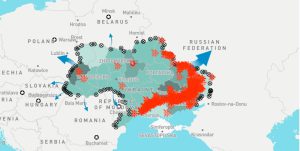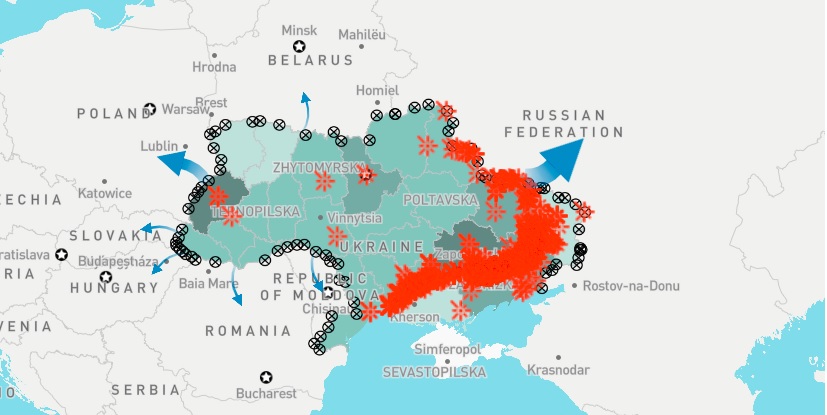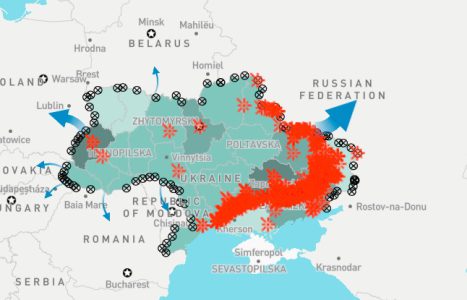
The Ukraine crisis following the escalation of the 2014 conflict into a full-scale war stopped the world in its tracks. But as the international organisations and donors poured into the country and the neighbouring host communities, the response has also become a testing ground for the newest use of technology for security, information and humanitarian action.
Modern technology allows us to revolutionise our daily lives, but also transpires into innovation in humanitarian action. Today’s technological fusion, that is the integration of information networks, mobile technologies, big data and social media into a single device of our choice such as a smartphone, gives us unlimited access to data from multiple sources and in a format of our choice. Such fusion is transforming the range of tools a promise new technology offers to humanitarian and conflict settings, employed across the spectrum of a war-torn country, from the civil defense mechanisms or information sharing. As mentioned by Read et al. (2015:7), “technology is co-constitutive of the humanitarian environments it seeks to capture. Rather than merely reflect, or compress, a picture, it has the capacity to construct and define it.” Let us then take a closer look at how technology defines the frame of the Ukraine response and where it can be perceived as a tool that contributes to colonialising humanitarian frameworks. Even though many might find it surprising to analyse the Ukraine response through a colonial lens, even though the country does not geographically belong to the global South, the infamous “open letter to international donors and NGOs who want to genuinely help Ukraine” issued by local organisations accusing international humanitarian giants of subduing them instead of facilitating access to global funds and resources shows that regardless of the location, the sector is painfully guilty of transplanting the same colonial narratives and models that endorse a localisation agenda solely on paper.
The military versus the humanitarian
Since ICT provides the opportunity to gather and covey data at a greater speed than through traditional means such as offline surveys, this promises better timeliness of humanitarian responses. In Ukraine, this transpires not only through speed to which international organisations have landed in the country and the accurate data charts visualising the conflict events and statistics, with exquisite graphic representation of the crisis available, such as the OCHA -HDX Ukraine data explorer, but also in a way which technological speed has been employed to help save lives in the civilian defense system and the innovative early warning system I wrote about in my blog article. Read’s claim to which that “technological advances in the humanitarian sector bring opportunities for the transformation of power relations between donors and ‘recipients’,” where crisis-affected populations “are increasingly becoming “digital communities” as well,” is vibrantly experienced in Ukraine today on the one hand, since refugees, internally displaced people (IDPs) and ordinary residents actively contribute to shaping the country’s defense and information landscape. Next to millions of users of the air alert apps, Ukrainians now have access to another app that allows them to detect and report Russian drone attacks. While the civil defense system seem to engage citizens at an equal footing, allowing them to collaborate with the governments and create a joint response to the ever-changing conflict landscape, alas the power relations in humanitarian programme delivery remain unshaken.
Even though modern cash programmes widely use technology as a seemingly egalitarian tool to reach to wide groups of people and boast the innovation of the efforts, the practical implementation on the ground still puts the clients in the position of a passive aid recipient. Over the course of the response, I have come across at least two examples of international organisations failing to timely harvest the power of technology to the benefit of the people. Cause of glitches in data transfer and a failure of the registration system in Poland and Ukraine respectively, with the latter going a step further and utilizing social media for registration purposes, people were left stranded without enough information about what is happening with the support. The NGOs’ inboxes and info lines were flooded with enquiries from people who had no idea where the money was to be found. This put the population in a position of a passive aid recipient, desperately knocking the western organisations’ doors to be heard and assisted. While cash registration is only one tangible example where technology is used to facilitate the response on both sides of the Ukrainian border, yet another of Read’s claim that data conversion and gathering has an impact on humanitarian responses is visible in Ukraine, it has no unequivocally positive impact on the local populations. While on the programmatic level ICT and advocates want to technologise every aspect of aid, glitches in the system prove that the current digital responses are far from perfect. These might also be exclusive to people with lower levels of digital literacy, such as the elderly, which is particularly applicable to Ukraine as the eldest crisis in the world, quoting the Norwegian Refugee Council. On the example of the African continent, Birhane (2019) notes that AI only seemingly seems to provide “quick solutions to complex social problems. And this is exactly where problems arise. Around the world, AI technologies are gradually being integrated into decision-making processes in such areas as insurance, mobile banking, health care and education services.” With the new banking partnerships emerging for the cash distribution programmes in Ukraine, with MoneyGram or other banking applications, nobody seems to question where the cutting-edge technologies are going to go in a few years, and what is going to happen with the users’ data. Also, why in the society where virtually each and every citizen gets access to Ukraine-developed apps that allow them to report drone attacks and seek shelter ahead of the upcoming shelling, need INGO intermediaries for cash transfers. “’Mining’ people for data is reminiscent of the colonizer attitude that declares humans as raw material,” argues Birhane, a statement that becomes particularly prominent in light of the Ukraine response.
Citizen information
Over the past few months, Ukraine has become a battlefield for (dis)information, with hundreds of corporate actors and (I)NGOs employing modern technologies to inform people about the assistance available, ensure the populations are free from harm, or inform the citizens about the latest military advancements. The conflict has also turned an ordinary citizen into a reporter, with platforms such as Live UA map and Telegram as the main source of information for the local populations. While we will not dwell deeper into the threats and opportunities around non-factchecked data and disinformation debates in Ukraine, we focus on the empowerment framework the access to ICTs offers on the ground today, with the individuals of the affected communities being presented with a unique opportunity to contribute to public information platforms. With dozens and new applications and communication platforms available a click away, dozens of people are dedicated to documenting atrocities and sharing the latest information from the frontlines, easily available on social media. As argued by Kleine (2010) multi-purpose technologies cam empower individuals to attain development outcomes of their own choice. Easier communication and more autonomy in knowledge production are clearly defined development outcomes that transpire from citizen information sharing activities. In Ukraine, the availability of ICTs translates into informational assets that contribute to the social change and fuel citizen engagement. Following the empowerment framework, “particular with respect to ICTs, relevant elements of the structure which influence an individual’s agency include dimensions of access, such as availability, affordability and capabilities needed for using different ICTs.” Read through this frame, the crowd sourcing of conflict and response data shifts the ownership of knowledge, since the information becomes a commodity co-shared by the citizens, as opposed to being the exclusive property of NGOs, Western media or UN agencies.
Taylor (2017) observes that “Data justice is the overarching conceptual framework within which research and debate can identify what freedoms people value with regard to data technologies, and how to realise them. It fits within the structure of opportunity freedoms and process freedoms that determines what people’s functionings (‘doings’ or ‘beings’) can be with regard to data technologies. In turn, these functionings can be translated via social conversion factors such as political, legal and educational support into capabilities such as participation in data value chains, or access to data affecting oneself.” Interestingly, Ukrainian society does strike back and if we were to apply the data justice framework to the realty on the ground, we could perceive the Ukrainian society as particularity empowered with this regard. Yet we are dealing with a war context which is reframed through a humanitarian localization agenda to defend particular INGO positions or justify the status quo, the technological freedom seems suppressed by the use of ICTs in partnerships that are far from equitable or supportive to local leadership and sustainability.
Digital humanicolonialism?
As Burns (2014) notes, “the digital humanitarian endeavour involves ‘different modes of production, processing, curation, and representation of people, places, and knowledges, that is, most often, digital humanitarianism enrolls spatially and socially-distanced people to work with local knowledges mediated through digital technologies.” In the Ukrainian response, starting from the use of ICT technologies to the digital representations of the crisis in media and external communications by INGOs, we still witness the traces of old dynamics being wrapped in the localization and modernization agenda. With INGOs trying to appropriate the response with the images of humanitarian suffering of the displaced Ukrainians and introduce ICTs an a tool to control the response, the cry of the local NGOs who see little of the billions of funding saying, “stop trying to speak on our behalf and stop controlling narratives in ways that advance your own institutional interests – and stop building our capacity!” seems particularly timely.
Bibliography:
Burns, R. (2014) Moments of closure in the knowledge politics of digital humanitarianism, Geoforum – Volume 53, Pages 51-62
Birhane, A. (2019) The Algorithmic Colonization of Africa., Real Life Mag, 9 July
Kleine, D. (2010) Journal of International Development, J. Int. Dev. 22, 674–692 , Published online in Wiley InterScience (www.interscience.wiley.com) DOI: 10.1002
Kwet, M. (2021) Digital colonialism: the evolution of American empire, ROAR, 3 March.
National Network of Local Philanthropy Development (2022) An open letter to international donors and NGOs who want to genuinely help Ukraine.
Peace Direct (2021): Time to Decolonize Aid-Insights and Lessons from a global consultation. London: Peace Direct.
Róisín Read, Bertrand Taithe & Roger Mac Ginty (2016) Data hubris? Humanitarian information systems and the mirage of technology, Third World Quarterly, DOI: 10.1080/01436597.2015.1136208
Sein, M.K., Thapa, D, Hatakka, M. & Sæbø, Ø. (2019) A holistic perspective on the theoretical foundations for ICT4D research, Information Technology for Development 25:1, 7-25.
Taylor, L. (2017) What is data justice? The case for connecting digital rights and freedoms on the global level., Big Data & Society, 4:2.

